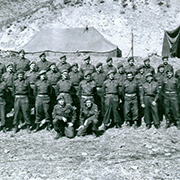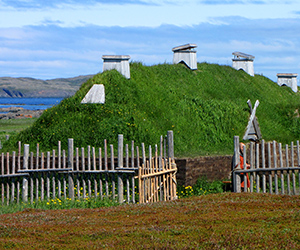CANADA HISTORY - War
The Brigade Arrives

 In the summer of 1950, as the conflict on the Korean Peninsula intensified and the United Nations called for military assistance to repel the North Korean invasion, Canada was faced with a critical decision. The Canadian government, under Prime Minister Louis St. Laurent, had already expressed its support for the UN's collective security efforts and recognized that Canada would need to play a more active role in the unfolding conflict. Yet, the nature of Canada's military involvement had to be carefully considered, especially in light of the Cold War and the potential need to keep a strong defense force available for North American security. With the Soviet Union seen as a looming threat, Canada's military leaders understood that any large-scale deployment to Korea could not come at the expense of the country's own defense.
In the summer of 1950, as the conflict on the Korean Peninsula intensified and the United Nations called for military assistance to repel the North Korean invasion, Canada was faced with a critical decision. The Canadian government, under Prime Minister Louis St. Laurent, had already expressed its support for the UN's collective security efforts and recognized that Canada would need to play a more active role in the unfolding conflict. Yet, the nature of Canada's military involvement had to be carefully considered, especially in light of the Cold War and the potential need to keep a strong defense force available for North American security. With the Soviet Union seen as a looming threat, Canada's military leaders understood that any large-scale deployment to Korea could not come at the expense of the country's own defense.
It was Lieutenant General Charles Foulkes, the Chief of the General Staff of the Canadian Army, who devised a solution that would meet both the international commitment and domestic security needs. Foulkes proposed the creation of a special brigade that would be separate from the core Canadian defense force, ensuring that Canada's mobile striking force remained intact and ready to respond to any threats closer to home. This brigade would be formed specifically for the United Nations action in Korea, drawing primarily from the ranks of World War II veterans who had returned to civilian life but were still within the age and fitness range for military service. The idea was that these seasoned soldiers, already experienced in combat, could quickly be trained and equipped for the new theater of war in Korea.
On August 7, 1950, Prime Minister St. Laurent made the official call for volunteers, asking former soldiers to step forward and join the new brigade. The response was swift and substantial. Veterans who had fought in the European and Pacific theaters during World War II came forward, eager to serve once again. For many of these men, the Korean conflict was a continuation of their previous service, framed within the broader context of the Cold War, where the defense of democracy was seen as paramount. These volunteers would form the backbone of what would become known as the Korea Brigade.
Structurally, the new brigade was designed as an extension of Canada’s existing military regiments. The brigade's core units were organized as second battalions of three of Canada's most prestigious regiments: The Royal Canadian Regiment (RCR), The Princess Patricia’s Canadian Light Infantry (PPCLI), and the Royal 22nd Regiment (Van Doos). These regiments had earned distinguished records during both world wars, and their traditions of excellence would now be carried into the Korean War. Each battalion was tasked with preparing its troops for a very different kind of warfare, one that involved harsh terrain, extreme weather conditions, and a determined communist enemy backed by China and the Soviet Union.
To lead this brigade, the Canadian government appointed Major General John M. Rockingham, a seasoned military leader with a distinguished service record from World War II. Rockingham had commanded the 9th Canadian Infantry Brigade during the Normandy campaign, earning the respect of his peers and subordinates for his tactical acumen and leadership under fire. He was widely regarded as one of Canada's most capable commanders, and his appointment to lead the Korea Brigade was met with widespread approval both within the military and in political circles. His leadership would prove crucial in shaping the brigade into a disciplined and effective fighting force.
Rockingham quickly set about assembling his command team, selecting battalion commanders from the ranks of experienced World War II officers. This decision ensured that the brigade would be led by men who had already seen combat and understood the demands of modern warfare. Under Rockingham's direction, the brigade rapidly expanded, reaching its full operational complement in a matter of months. The men were brought together from across Canada, and the training process began in earnest.
 The final phase of the brigade’s preparation took place at Fort Lewis, in Washington State, an American base chosen for its warmer climate compared to the available Canadian training grounds. The weather in Fort Lewis was considerably milder than in Canada, allowing for year-round training that was essential for readying the brigade for the Korean theater. The training regimen focused on preparing the men for the specific challenges they would face in Korea: the mountainous terrain, the cold winters, and the intense, often close-quarters combat that characterized much of the fighting on the peninsula.
The final phase of the brigade’s preparation took place at Fort Lewis, in Washington State, an American base chosen for its warmer climate compared to the available Canadian training grounds. The weather in Fort Lewis was considerably milder than in Canada, allowing for year-round training that was essential for readying the brigade for the Korean theater. The training regimen focused on preparing the men for the specific challenges they would face in Korea: the mountainous terrain, the cold winters, and the intense, often close-quarters combat that characterized much of the fighting on the peninsula.
It was during this period of training that the brigade was officially designated the 25th Canadian Infantry Brigade, reflecting its role as part of the broader Commonwealth and UN efforts in Korea. Training at Fort Lewis continued through the fall and winter of 1950-1951, with the soldiers honing their skills and adapting to the modern weaponry and tactics they would need to employ against the North Korean and Chinese forces. This preparation was critical, as the soldiers would be stepping into a war that had already claimed thousands of lives and had become a brutal, grinding conflict of attrition.

By March 1951, after several months of intensive training and logistical preparations, the 25th Brigade—now numbering around 8,000 troops—was ready for deployment to Korea. The brigade had been outfitted with the latest equipment, including artillery, vehicles, and communication tools, ensuring that they could operate effectively in the complex and challenging Korean terrain. Under Major General Rockingham’s leadership, the brigade was now prepared to join the Commonwealth Division, which included British, Australian, and New Zealand forces already engaged in combat on the peninsula.
 The deployment of the 25th Brigade marked a significant moment in Canada’s contribution to the Korean War. It was the culmination of months of planning, recruitment, and training, and it underscored Canada’s commitment to the United Nations and the doctrine of collective security. This brigade would soon prove its worth in some of the most challenging battles of the war, including the Battle of Kap’yong, where Canadian forces played a key role in preventing a major breakthrough by the Chinese army.
The deployment of the 25th Brigade marked a significant moment in Canada’s contribution to the Korean War. It was the culmination of months of planning, recruitment, and training, and it underscored Canada’s commitment to the United Nations and the doctrine of collective security. This brigade would soon prove its worth in some of the most challenging battles of the war, including the Battle of Kap’yong, where Canadian forces played a key role in preventing a major breakthrough by the Chinese army.
Cite Article : Reference: www.canadahistory.com/sections/documents/documents.html
Source: NA



